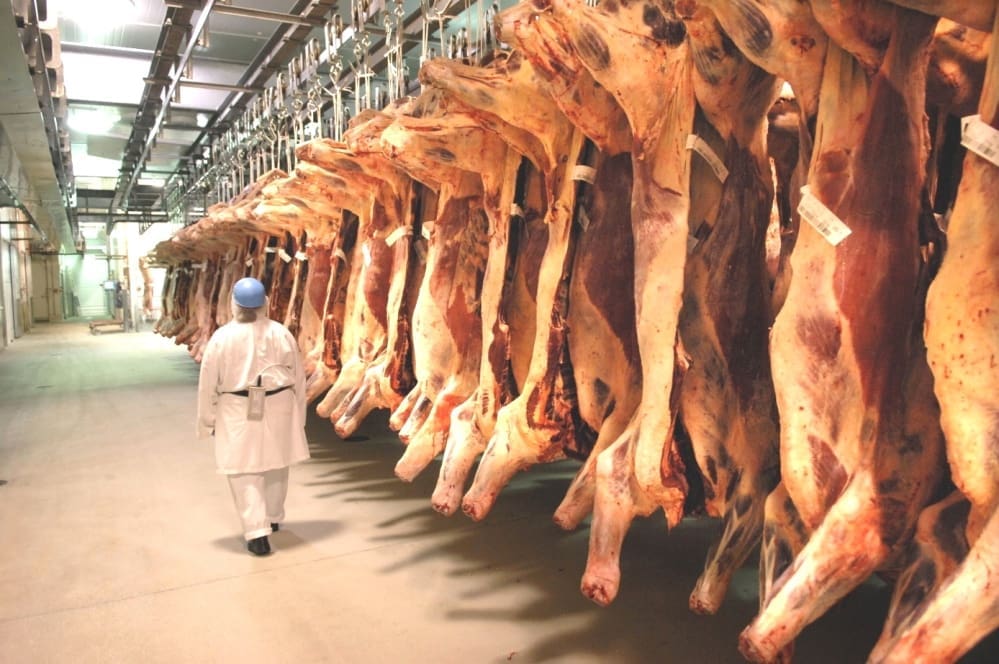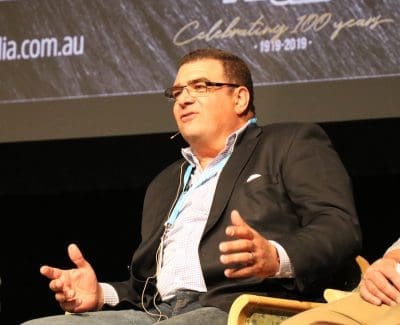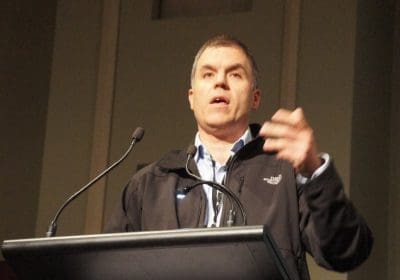
THE world’s first beef boning automation research & development room will be built at Teys Australia’s Lakes Creek processing facility near Rockhampton in Central Queensland.
Underpinned by the red meat industry’s need to reduce processing costs and increase boning room yield efficiency, a five-year project worth up to $32.4 million will be funded through the MLA Donor Company by Teys Australia, the Federal Government and the Australian Meat Processor Corporation, through the Processor Initiated Projects program. No producer or processor levies will be involved.
Project collaborators will include Scott Technologies, which had led the development of the DEXA technology in lamb, and Rapiscan, the company which has developed high-speed scanning systems for airport baggage security.
The beef boning automation technology project, to be known as Leap4Beef’, follows the LEAP lamb boning automation project.
The Rockhampton installation will see a large R&D room developed, enabled by both the existing DEXA (dual-energy X-ray absorptiometry) objective carcase scanning technology installed at the plant, as well as CT scanning technology to provide further carcase information on yield and quality.
Rockhampton was chosen for the project for several reasons. The first is that the existing DEXA scanner is already stationed there, for yield trial work. The second is that the site has the ‘real estate’ available to build the R&D facility, without disrupting everyday processing operations.
A large room will be constructed where the robotics and automation experimentation can take place. A number of robotic arm ‘cells’ will be installed, tackling certain parts of the primary boning operation, based on guidance on each carcase provided by the DEXA and CT scanners.
The robots will make a series of cuts on each carcase, including both bone-sawing functions and muscle-cutting, designed to simplify and improve the manual boning processes which follow.
The placement of some of those cuts are absolutely critical in ensuring that maximum value is retained in each carcase. Similar trials on lamb carcases has proven that robots will perform these functions more consistently than manual operators, and will perform the ‘right’ cut, time after time.
As the systems prove themselves ‘off-line,’ they can then be taken into Lakes Creek’s commercial production line for ‘on-line’ trials under commercial conditions.
Maximising efficiency, competitiveness
Australian processing is among the most expensive in the world, and automating the beef boning process would reduce per head operating costs for the benefit of the entire Australian industry.
The Australian Meat Industry Council’s Cost to Operate report last year showed Excluding livestock purchases, the average cost per head incurred in processing beef in Australia is 24 percent higher than that in in the US, 75pc more than Argentina and more than 100pc higher than in Brazil. The report suggested that cost reduction was the only way the industry can compete with other global beef exporters.

MLA managing director Jason Strong
MLA managing director Jason Strong said optimising the value of carcases through accurate cutting would improve boning room yield efficiency, along with the increase in productivity through continuous flow in the boning room, was vital to the sustainability of the Australian red meat industry.
“Beyond movement in livestock prices, the single biggest impact on processing efficiency is the accurate segmentation and deboning of carcases into the highest primal value possible. It’s where the most significant improvements in processing industry efficiency can be made,” he said.
Beef boning automation had been estimated to deliver a benefit worth at least $30 per head, with an estimated 40pc of this benefit to return to producers, Mr Strong said.
“The developments will also provide a platform for other value adding outcomes, such as increasing producer feedback through DEXA and CT installations.”
The industry was already seeing the benefits of lamb boning automation in Australian processing plants, with carcase values increasing by more than $6/head. More than 40pc of large lamb processing throughput now used the technology, and pending new installations this would rise to 71pc of lamb throughput, Mr Strong said.
Teys Australia chief value chain officer, Tom Maguire said beef processing was one of Australia’s largest manufacturing industries employing thousands of Australians in rural and regional communities and the type of investment being seen in the project would help us secure the sector’s future for the long term.

Teys Australia’s Tom Maguire
“Around that world manufacturing has shown that it can maintain a competitive advantage provided it adopts the latest technologies and embraces the digital economy. There is no reason that the beef processing industry cannot be part of this,” Mr Maguire said.
He said that Teys commitment to the project was because Australian cattle producers produced some of the best product in the world, and a modern, efficient and productive processing system could ensure it maintained this position in the future.
Automation of critical beef cutting lines had the potential to greatly improve consistency and quality of product offered to customers, whilst improving the working conditions in plants.
“While we have much work to do to deliver an outcome, we are committed to getting the best and brightest minds to work with us on the project and getting the job done,” he said.
Slow process
The project has an anticipated horizon of 5-7 years, but it could be longer, Mr Maguire told Beef Central.
He conceded that it sounded like a ‘slow process’, but said it was likely in years to come that the stakeholders would “look back at the first concepts trialled and have a laugh.”
“There will be lots of learnings along the way, because this is a very new field. This work cannot be done in a Computer Aided Design drawing – it’s trial and error,” he said.
“We’d be delighted of progress is made sooner, but realistically, the equivalent lamb robotics process in fact took many more years than that. It’s going to be considerable time over many years to get it right.”
Construction of the research facility itself would take 12 months, meaning first experiments in performing cuts on beef carcases using robots was likely to start towards the end of next year. In advance of that, laboratory trial work was already underway through Scott Technology.
Body mass challenges
Asked whether the challenges surrounding the effectiveness of DEXA scanning on beef carcases due to their much larger body mass than lamb carcases had been resolved, Mr Maguire said trials using the current DEXA machine installed at Rockhampton had given collaborators Scott Technology and Teys confidence that the system (even before the overlay of CT scanning) could locate the critical points on the carcase with enough precision to effectively instruct the robot systems.
“The process to get a robot to cut where it is told to is actually pretty straightforward. The sensing and analysis of each carcase for where to cut is the tricky bit,” he said.
Mr Maguire said Teys remained committed to sharing the data produced from the automation project via DEXA assessment for yield with producers. That process started with the earlier yield assessment trial, currently generated by camera systems, but ultimately by DEXA and CT scans.
There is an industry imperative to get this project done,” Mr Maguire said.
Australia is a high-cost beef processor by world standards, and manufacturing in general around the world has only prospered where it has innovated and adopted technology.”
Fututech scars?
Beef Central asked Mr Maguire whether the industry was still ‘psychologically scarred’ over what happened with the incredibly ambitious and expensive, but ultimately failed Fututech beef processing robotics/automation project of the early 1990s.
“What the industry cannot afford to do is let its ‘mindset’ be the reason the beef boning automation project does not happen,” he said.
“Are all the parts of the solution there today to make this work? No. But we confident that they will be as we go along the journey, because the rate of technological change that’s occurring.”
Asked whether the project, if it proves successful, would ultimately reduce staffing levels at Lakes Creek and other beef plants, Mr Maguire said it would be ‘quite the opposite.’
“We are not anticipating significant reductions in labour, if any,” he said. “Staff that previously performed these functions manually will be deployed elsewhere on the site. What we are trying to do is create better, safer and less repetitive jobs elsewhere along the chain, while definitely improving the revenue we can create from each body. Better microbial performance through less human intervention is a bonus,” he said.
“But we definitely would not justify this project on labour saving alone,” he said.
Ultimately, through the application of CT scanning, the project may go beyond assessing each carcase for best cutting lines for robots, to potentially seeking out finer carcase characteristics to assist or replace manual carcase grading.
At the moment the standard industry practise was to cut the carcase to expose the striploin to allow grading to be performed, either manually or using a camera, Mr Maguire said.
“But an exciting prospect is in not having to do that, and using scanning systems and other technologies still in the concept stage, to make those grading assessments without making the cut on the carcase.”
“Handling each carcase from an automation perspective is going to be a lot easier if we don’t have to cut it to perform grading,” he said.
Sharing findings with industry
MLA managing director Jason Strong said the industry service delivery company had undertaken industry consultation with more than 20 processors on beef boning automation in advance of the new project, and would continue to work with other Australian processors and hold regular updates.
“The beef boning automation R&D room will be available for any solution-provider to develop MLA/Teys approved initiatives, and will be open for Australian processors to visit to see the developments and evolution of the technology,” he said.
Teys plans to hold a series of open days and demonstrations at the site as major milestones are reached.

Would like to see what they have so far. Is full automation too far, do we need to get some grounding on certain areas of the body first.
High hopes,or a lot of money to waste, Automation has been tried in the mutton processing industry, but now most of theses machines sit idle. They are either to expensive to maintain or nobody knows how to service them when they do malfunction.
Thanks for your comment Shane.
We’ve made some inquiries, and can present the following background information on the points you’ve raised. It’s important to remember that technology in this field has travelled light-years in the past two decades:
During the mid to late 1990s, a handful of Australian mutton processors purchased mutton deboning equipment from an international company. As the technology had no advanced sensing technology (such as DEXA or CT), the deboning yield compared to manual deboning was sub-standard. At the time this was not a commercial problem, as the value of mutton (and resulting yield loss) was considerably less than that of the cost of labour. As the value of mutton has increased, at a greater percentage than about labour rates, the reduced yield as a result of using this 1990’s equipment (with no sensing) meant that the all of the equipment has been removed by the late 2000s.
This lack of advanced sensing and reduced resulting yield is also why lamb processors never adopted the technology at the same time as the mutton processors in Australia. Since early 2000s, MLA has worked with an international solution provider to developed advanced sensing lamb deboning equipment, now using DEXA, that has a substantial yield improvement over manual deboning. These systems, developed in the early to mid 2000s, are now installed in a substantial way in four Australian processing plants (a fifth underway), with components of the solution in three other Australian lamb processing plants. New Zealand lamb processing plants have also adopted this DEXA-enabled lamb deboning system in a significant way. There are more installations coming in New Zealand. The Australian and New Zealand installations have been operational for more than 12 years now.
Editor
The spinal column and associated processes dorsal and transverous should be removed prior to chill .
If done properly the splitting of the carcass is eliminated. Improving chill times and allowing for tender stretch applications
Spinal column and associated processes have a value above render so labour cost and product value and all positive outcomes.
Thanks Paul
Well done to everyone involved in getting this positive, progressive program up. Howard Smith
Mt Panorama
Rolleston
You say no producer funds will be spent is that so for mla funds.???
Who will own the technology ???
Thanks for your comment Henry. We’ve been told there are no producer or processor levy funds involved. As we understand it, the sole contributors, managed through the MLA Donor Company, are the Federal Government (dollar-for-dollar funding support for R&D), and Teys Australia, both directly and as part of its AMPC Processor Initiated Projects (PIP) contribution. Editor